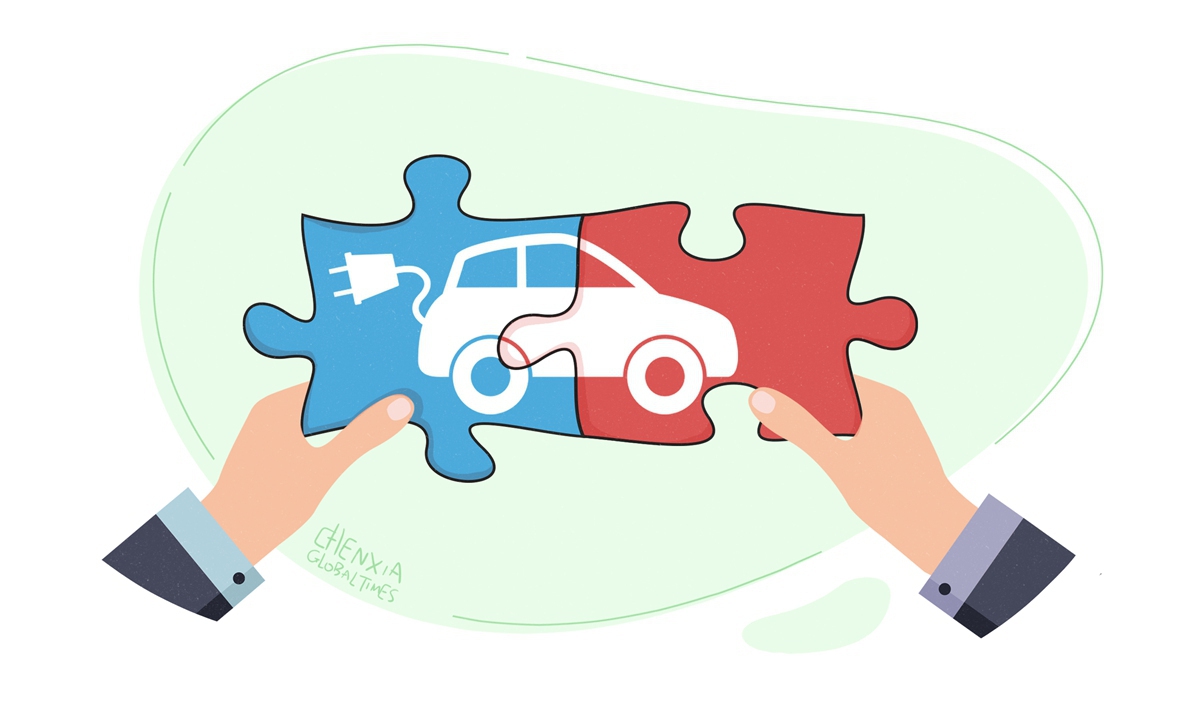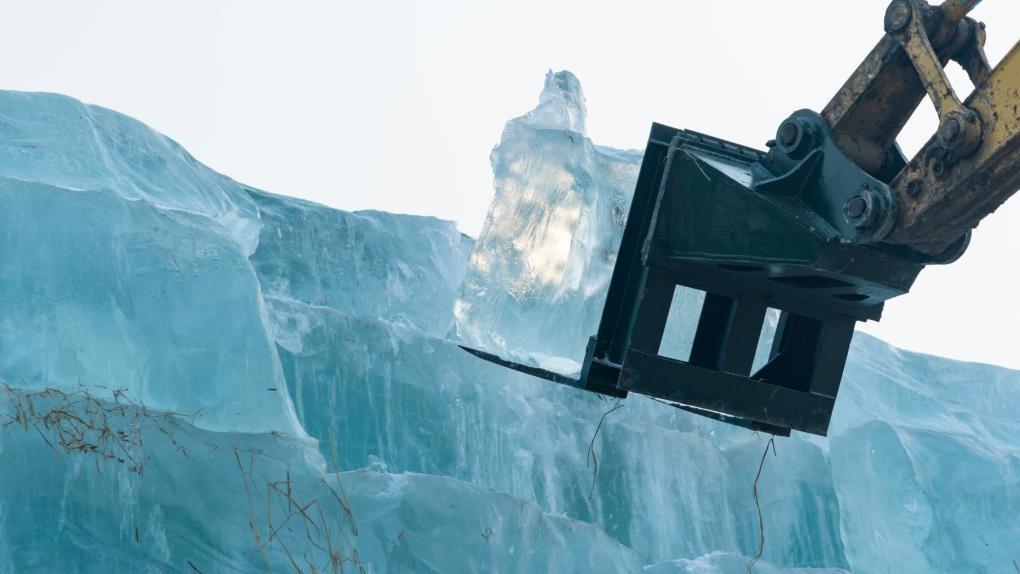Volkswagen’s choice another reflection of win-win co-op with China

Illustration: Chen Xia/GT
"Strategic milestone reached." On Tuesday, Germany's Volkswagen Group announced on its website the completion of its new full-platform testing and R&D center - the Volkswagen Group China Technology Company (VCTC) - in Hefei, East China's Anhui Province. This new center is the first in Volkswagen's history capable of completing a full vehicle-platform development cycle - from concept to market readiness - outside Germany. This strategic move, hailed by the industry as the "Hefei model," represents deep China-Germany synergy amid the sweeping transformation of the global automotive sector. It punctures the illusion promoted by some Western politicians about "decoupling" from China, and provides the world with a convincing case of win-win industrial cooperation.
According to the British media outlet Financial Times, once operational, the Hefei R&D center will cut vehicle development cycle by about 30 percent, while costs for certain new models could fall by as much as 50 percent. In essence, Volkswagen has found a breakthrough to enhance its competitiveness by "actively taking root" in China. In the anxious rhetoric of some Western politicians, China's industrial competitiveness will "undermine European industries," with some even framing China's development as a "threat." But Volkswagen's success in China demonstrates that working together with China yields win-win outcomes where 1 + 1 >2.
The launch of the Hefei R&D center reflects China's evolving role in the global industrial landscape. In the past, products developed in Germany were later introduced to China, where China's role was mainly that of "assembly line" and "sales terminal." Today, the establishment of Volkswagen's testing and R&D center in China shows that the country has moved from being the "world's factory" to becoming "a hub of innovation."
China is now widely recognized as the world's most competitive auto market and a "frontline testing ground" for the electrification and intelligent transformation of automobile manufacturing, where new technologies emerge at a rapid pace. In today's deeply globalized world, when facing an economy like China that combines market scale, innovative dynamism, and a complete industrial system, "cooperation" makes far more commercial and historical sense than "decoupling." This is also the fundamental logic behind Volkswagen's consistent commitment to its "In China, for China" strategy.
From a "manufacturing powerhouse" to an "innovation leader," China is embracing global partners with an open posture. The establishment of Volkswagen's Hefei testing and R&D center is a vivid example of China's ongoing efforts to expand opening-up and optimize its business environment. Whether it is the removal of all foreign investment restrictions in manufacturing, the continued expansion of visa-free policies, or the development of free trade zones and free ports, China's high-level opening-up has provided multinational companies with unprecedented predictability. Amid global industrial transformation and shifting trade patterns, China is using the certainty of its own opening-up to offset the uncertainty that rising protectionism is bringing to the world.
Seen in this light, Volkswagen's statement "In China, for China" is in fact closer to "In China, for the world." Reuters reports that Volkswagen has already begun exporting China-made models to the Middle East and plans to further expand into Southeast Asia and Central Asia, looking to "leverage its growing know-how in Chinese technologies" to compete globally. The Hefei testing and R&D center not only enriches choices for Chinese consumers but also strengthens China's role as a "new global innovation laboratory." It will not only witness mutually beneficial cooperation between the two countries, but also help elevate the global automotive manufacturing industrial chain and contribute to building a healthier and more resilient supply chain.
Amid the rise of China's high-end manufacturing, Volkswagen has chosen to "actively integrate" rather than "build walls and isolate." This provides a highly valuable reference model for all multinational companies. Volkswagen is far from an isolated case; Tesla has built a Gigafactory in Shanghai, BMW has established four major R&D and innovation bases in Beijing, Shanghai, Shenyang, and Nanjing, and Toyota will transfer the decision-making authority for developing future models in China from its headquarters in Japan to China... Beyond the automotive industry, more multinational companies are achieving deeper and higher levels of localization in China. For example, Phoenix has launched a full-value chain gigafactory project in Nanjing, France's bioMérieux has established an open innovation center in Shanghai to empower "Pudong manufacturing," and 50 percent to 60 percent of the clothing sold by Adidas in China is designed and developed in the country. The practices of multinational companies in China continually demonstrate that the essence of "win-win cooperation" is respect for market rules, which serves as a "passport" for crossing industrial cycles and truly managing risks.
The global industrial chain is undergoing a profound restructuring, and China, with its emphasis on high-quality development and high-level opening-up, is transforming this restructuring into new opportunities for common development. Volkswagen's choice is a clear vote for the times and another reflection of win-win cooperation with China. We hope that countries can transcend zero-sum game thinking and deepen cooperation with China in fields such as technological research and development, standard-setting, and market expansion, jointly cultivating new quality productive forces and collaboratively creating a new era of high-quality development. "In China, for China," is not only about winning together with China but also about winning together with the future.
Photos
 Int'l delegation explores organic tea culture in Baisha, S China's Hainan
Int'l delegation explores organic tea culture in Baisha, S China's Hainan Chamber Concert of Chinese Classical Music held at China Cultural Center in Kuwait
Chamber Concert of Chinese Classical Music held at China Cultural Center in Kuwait 27th Harbin Ice-Snow World to officially begin construction in NE China
27th Harbin Ice-Snow World to officially begin construction in NE China Promotion week for intangible cultural heritage brands opens in Dali, China's Yunnan
Promotion week for intangible cultural heritage brands opens in Dali, China's Yunnan
Related Stories
- China becomes Germany's top trading partner in first 3 quarters
- Border trade thrives at ports in China
- China's trade corridor sees surge in road freight
- Three?perspectives on five years of change in China's foreign exchange market
- China's foreign trade shows resilience with steady growth in first 10 months
- Linyi Trade City's rise from roadside stalls to international shopping hub
- Chinese carriers launch new intl cargo routes, giving boost to regional trade
- China unveils new measures to facilitate cross-border trade
- Yiwu trade tops 600 billion yuan in first 9 months of 2025, as surge in foreign buyers accelerate business confidence
- 'Trade is mutually beneficial, should not be weaponized,' says Justin Yifu Lin
Copyright © 2025 People's Daily Online. All Rights Reserved.





